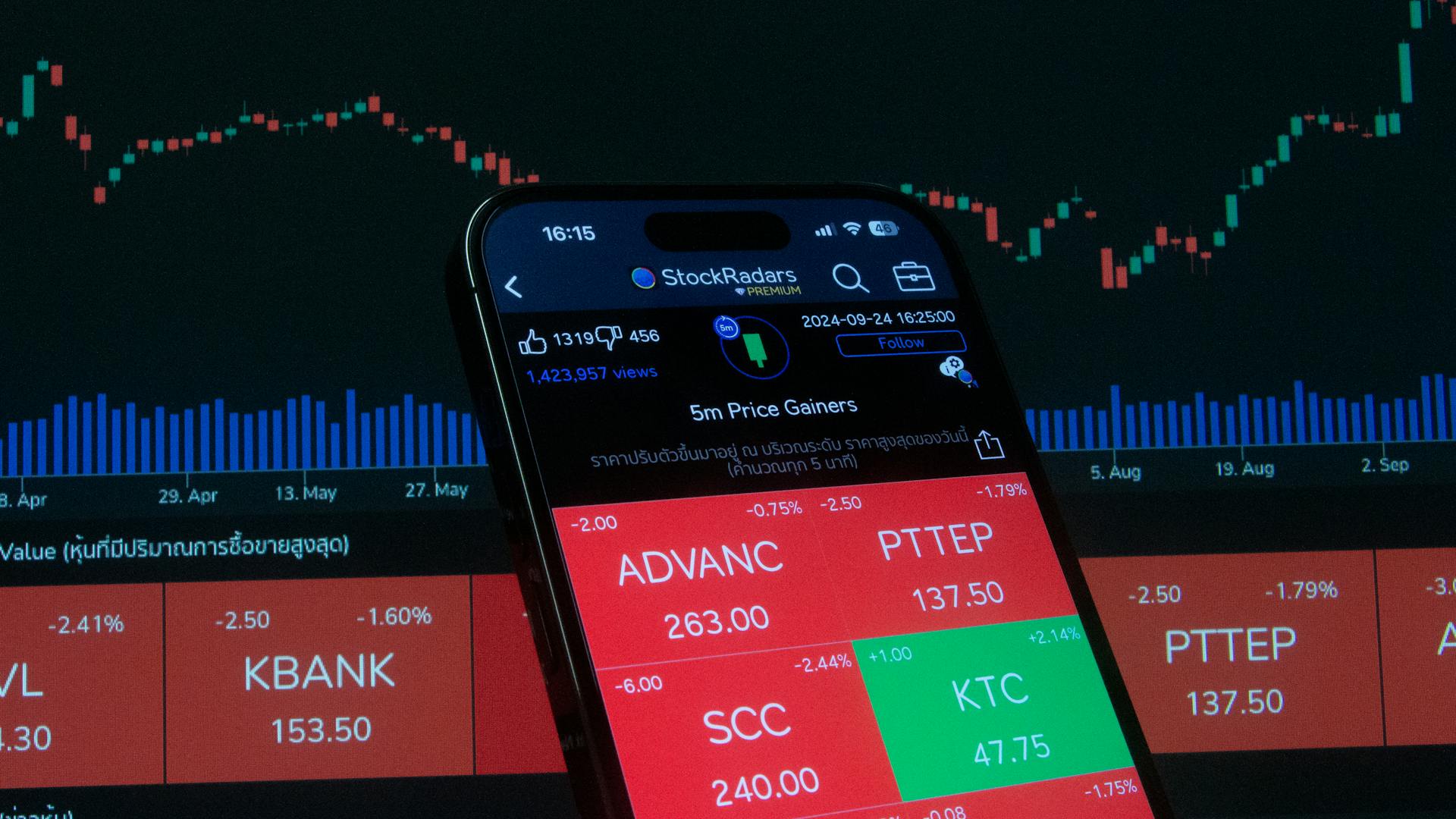
Phantom stock and Stock Appreciation Rights (SARs) can be complex and confusing, but understanding them is essential for anyone dealing with equity compensation.
Phantom stock is a type of equity compensation that mimics the performance of actual company stock, but without the actual shares being issued.
Phantom stock plans are often used by private companies or those with limited public float.
Phantom stock values are typically tied to the performance of the company's actual stock.
Explore further: Phantom Shares vs Equity
Benefits and Drawbacks
Phantom shares of stock can be a great way for employers to reward employees without giving up ownership, but they also have some drawbacks.
Phantom stock plans can be used by closely held corporations to reward employees without having to shift ownership, and some publicly traded firms use them too.
Employees can benefit from their company's growth without owning shares, which can be a big plus for those who don't want to deal with the responsibilities of actual ownership.
The company can also offer incentives without diluting ownership or control, which is a big advantage for employers.
However, employees don't have voting rights, don't receive dividends, and don't have actual ownership shares in the company, which can be a drawback.
Payouts are taxed as ordinary income, which may be higher than long-term capital gains tax rates for actual stock, which can be a disadvantage for employees.
Here are the key benefits and drawbacks of phantom shares of stock:
Tax and Planning Considerations
Tax and planning considerations for phantom shares of stock are crucial to avoid potential pitfalls.
Care must be taken to avoid giving out too much phantom stock to early participants and not leaving enough for later employees. This is a key planning issue that companies must address.
The equity of the company must be valued in a defensible and careful way to ensure that the phantom stock plan is fair and equitable for all participants.
Tax and regulatory problems may make phantom stock more dangerous than it seems.
Companies may be subject to an excess accumulated earnings tax if they accumulate too much cash to pay for the benefit.
Funds set aside to pay for the benefit may need to be segregated into a "rabbi trust" or "secular trust" to avoid causing employees to pay tax on the benefit when it is promised rather than paid.
Phantom stock payouts are generally taxed as ordinary income for the employee when received. The company can typically deduct the payouts as a compensation expense.
Here are some potential tax implications of phantom stock:
- Phantom stock payouts are generally taxed as ordinary income for the employee when received.
- The company can typically deduct the payouts as a compensation expense.
- Specific tax implications depend on the structure of the plan and the jurisdiction.
Employee Plans and SARs
Phantom stock plans can be structured in different ways to suit various employee levels and roles. Companies can customize phantom stock plans to align rewards with different employee tiers, such as senior executives receiving full-value plans and mid-level employees having access to appreciation-only plans.
Phantom stock plans often come with vesting schedules, which means employees may not receive any payout if they leave the company before fully vesting. The main risk that employees are exposed to is the company's stock performance, which can reduce or eliminate the potential financial benefits.
Discover more: How Are Stock Speculators Different from Stock Investors
Phantom stock plans can be tailored to specific performance goals or periods, allowing companies to align rewards with their goals. Employees can benefit from the company's growth without owning shares, and the company can offer incentives without diluting ownership or control.
Phantom stock plans can be structured as appreciation-only plans or full-value plans, with the latter paying the value of the underlying stock and any appreciation. Here are the key differences:
- Appreciation-only plans pay out only the value of any increase in the company stock price.
- Full-value plans pay the value of the underlying stock and any appreciation.
Customizing Employee Plans
Companies can tailor phantom stock plans to suit various employee levels and roles, allowing them to align rewards with different employee tiers.
Senior executives may receive full-value plans that include both the stock's value and appreciation, while mid-level employees might have access to appreciation-only plans.
This flexibility is beneficial for companies, as it enables them to grant fewer shares while still providing competitive grant value, especially when employee retention is a concern.
A key advantage of phantom stock is its flexibility, giving the organization the freedom to structure the plan how it wishes.
A fresh viewpoint: How Does Selling Shares on the Stock Exchange Benefit Companies

Phantom stock plans can be customized to include a vesting schedule, payout after a predetermined event such as retirement or termination, or a combination of both.
Companies can choose which employees participate in the plan, making phantom stock plans discriminatory.
Here's a breakdown of the two types of phantom stocks:
- Appreciation-only plans: pay out the value of any increase in the company stock price over a certain period.
- Full-value plans: pay the value of the underlying stock and any appreciation.
Risks of SARs for Employees
The risks of SARs for employees are real and can have a significant impact on their financial well-being. If the company performs poorly, the potential financial benefits may be reduced or lost.
One of the biggest risks is that employees may not receive any payout if they leave the company before fully vesting. This can be a major financial blow, especially if they've been counting on the SARs payout as part of their compensation package.
If you're considering a SARs plan, it's essential to carefully review the vesting schedule to understand when and how you'll receive your payout.
When Introduced?

Phantom stock plans were first introduced in the 1950s as a way for companies to provide key employees with long-term incentives tied to the company's success.
The concept of phantom stock gained popularity in the 1980s as an alternative to traditional stock option plans, offering a new way for companies to motivate and reward their employees.
A unique perspective: What Companies Are Publicly Traded
Impact on Cash Flow and Organization
Phantom stock and SARs can significantly impact a company's cash flow, particularly when large payouts are due. This is because these plans are often settled in cash.
Companies need to set aside reserves or plan payouts to match with periods of strong cash flow to prepare for these financial obligations.
Discover more: Cash Return on Capital Invested
How SAR's Impact Cash Flow
SARs can significantly impact a company's cash flow, particularly if the stock value increases rapidly. This is because SARs are often settled in cash, requiring companies to be prepared for large payouts.
Companies need to set aside reserves or plan payouts to match with periods of strong cash flow to prepare for these financial obligations. This is especially true if the stock value increases significantly, as seen in phantom stock and SARs plans.
Companies must be ready to pay out SARs in cash, which can be a substantial financial burden.
Consider reading: Future Cash Flows Expected from Investment Projects Blank______.
Organizational Benefit

Phantom stock can be used as an incentive to upper management, tying a financial gain directly to a company performance metric.
This approach can also be used as a reward or bonus to employees who meet specific criteria, such as performance, seniority, or other factors.
Phantom stock can be given to every employee, either across the board or distributed according to performance.
Phantom stock provides organizations with a way to offer incentives tied to stock value, which can be beneficial for limited liability corporations, sole proprietors, or S-companies restricted by the 100-owner rule.
Phantom stock can be distributed according to performance, seniority, or other factors, making it a flexible incentive option for organizations.
Is Legal?
Phantom stock plans are indeed legal and are widely used by companies as a form of employee compensation.
The specific terms and conditions of the plan must follow applicable laws and regulations, such as those related to taxation and securities.
Phantom stock plans are a legitimate way for companies to reward their employees, and many businesses have successfully implemented them.
To ensure compliance, companies must carefully design their phantom stock plans to meet the necessary legal requirements.
Discover more: Publicly Traded Companies by Sector
Frequently Asked Questions
Are phantom shares worth it?
Phantom shares offer a reward for increasing share price, but they don't provide actual ownership or control, making them a limited benefit for executives. Whether phantom shares are worth it depends on individual circumstances and priorities.
What is an example of a phantom share?
Here is a concise FAQ answer: "Phantom shares are a type of stock award that mimics the value of actual company stock, but doesn't represent actual ownership. An example is an employee granted 1,000 phantom shares worth $50 each, which could be worth $75 each after a three-year vesting period
Can phantom shares be sold?
Phantom shares can't be directly sold, but their value may be realized through annual distributions of profits if structured correctly. Liquidity can be a challenge with phantom shares, unless the company has strong cash flow.
Sources
- https://www.nceo.org/articles/phantom-stock-appreciation-rights-sars
- https://www.boardmanclark.com/publications/business-minute/specific-types-of-equity-compensation-phantom-stock-and-stock-appreciation-rights
- https://www.investopedia.com/articles/stocks/12/introduction-phantom-stock.asp
- https://www.investopedia.com/terms/p/phantomstock.asp
- https://en.wikipedia.org/wiki/Phantom_stock
Featured Images: pexels.com


